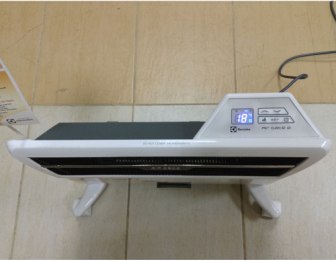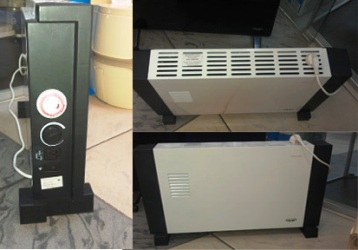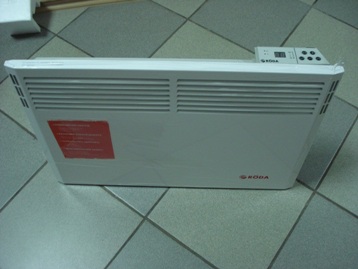Categories: Featured Articles » Novice electricians
Number of views: 153442
Comments on the article: 12
The device and principle of operation of the electric convector
 An electric convector is one of the most popular heaters used for heating domestic, industrial and office premises. Despite the fairly wide popularity of this type of heater, few people have an idea of how it works, and for what these or those convector control elements serve.
An electric convector is one of the most popular heaters used for heating domestic, industrial and office premises. Despite the fairly wide popularity of this type of heater, few people have an idea of how it works, and for what these or those convector control elements serve.
Consider the principle of operation of a convection heater. The principle of operation of an electric convector is based on the natural circulation (convection) of air. The convector, as a rule, has a rectangular shape, an electric heating element is located inside it.
On the surface of the convector there are openings designed for air circulation. The convector is designed in such a way that the air coming from the bottom and side openings is heated after passing through the heating element and then exits through the openings located on the front panel of the convector.
For instance, oil type heater Heats the room due to thermal radiation, which comes from heated radiators. The convector has a different principle - heating the room is due to the directed flow of heated air. Due to this, the convector heats the room much faster and, what is equally important, evenly over the entire area.
The heating element of a modern convector is low temperature, it is made of a special alloy, so that it heats up much faster than ordinary tubular heating elements. As a rule, after 30-60 s after switching on the mains, the convector already begins to transfer heat to the room.
The efficiency of a heater of this type reaches 90% due to the fact that almost all the energy goes into heating the room, unlike other types of heaters, for example, oil heaters, which do not begin to transfer heat to the room immediately, but only after its heat-conducting medium warms up - oil, and then its metal casing (radiator).

It is believed that heaters, including electric convectors, burn oxygen. But is it really so? As mentioned above, low-temperature heating elements are installed in the electric convector, the maximum temperature of their heating, as a rule, does not exceed 600 60aboutFROM.
At this temperature, oxygen is not burned, which is a significant advantage of the convector, compared with other types of electric heaters, the heating elements of which are heated to several hundred degrees. In addition, the low working temperature of the convector allows it to be installed almost everywhere, including near fire hazardous surfaces, for example, on a wooden wall.
And how can a convector effectively heat a room if the operating temperature of its heating elements is much lower than in other types of heaters?
The convector heating element has a significantly larger size compared to heating elements that have a higher operating temperature. Due to this, the convector generates a sufficient amount of heat and, despite the low operating temperature of its heating elements, it is able to heat a significant area. Depending on the power, one convector can heat a room with an area of up to 30 square meters. m

Most convectors install a thermostat, which is designed to adjust the temperature of the heating element and, accordingly, the temperature of the air that moves away from the convector. On cheaper models, mechanical thermostats are installed, with which the temperature is adjusted roughly.
Dear models are supplied electronic thermostatsthat allow you to adjust the temperature with high accuracy - up to a tenth of a degree. Accurate temperature control is not so important for domestic use. If the room is cold and you need to warm it up faster - the thermostat is set to the maximum temperature. Upon reaching the optimum and comfortable temperature, the thermostat can be set to a lower temperature value.
The accuracy of temperature control is relevant when it is necessary to maintain temperature in those rooms where it is necessary to observe strict temperature conditions. Thanks to the electronic thermostat, it is possible to automatically adjust the room temperature.
In addition to the thermostat, a switch is provided on the electric convector for supplying voltage to the heating element. In convectors with a power of 1500-2500 W there can be 2-3 heating elements and, accordingly, a switch to several positions. For example, when installed in the first position, one heating element is switched on, in the second position - two heating elements, and in the third position, the convector operates at full power - that is, all three heating elements are turned on.
On some types of electric convectors, independent switches are installed for each of the heating elements. This option of turning on the heating elements is most acceptable, since in the event of a burnout of one heating element, you can turn on another, which is in good condition, while when a heater burns out in a convector with a step switch, it is highly likely that in none of the switch positions the convector will not work.
The presence of a thermostat and switches of the heating elements allows you to adjust the temperature of the air heating in a fairly wide range.
Electric convectors can be mounted directly on the wall or mounted on the floor. If a heater of this type is installed on the floor, there is a danger of it toppling over, which can cause a fire. Therefore, in almost all convectors, a special protective device is provided that automatically turns off the power to the heating elements in case of accidental or spontaneous tipping of the convector.
The principle of this protective device is as follows. When the convector is in an upright position, the contacts are closed, and the heating elements of the convector receive power. In the event of a rollover of the convector, that is, when the angle is deviated from the vertical position, the contacts of the protective device open and the convector heating elements are de-energized.
It should be noted that the convector operates in normal mode only if unhindered air circulation occurs. Therefore, in order to avoid the failure of the convector, it is forbidden to cover it.
See also at i.electricianexp.com
:

